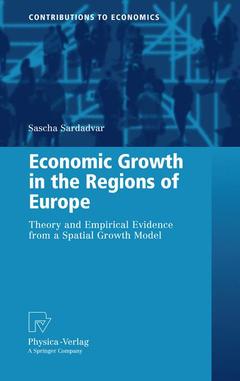Description
Economic Growth in the Regions of Europe, 2011
Theory and Empirical Evidence from a Spatial Growth Model
Contributions to Economics Series
Author: Sardadvar Sascha
Language: English
Subjects for Economic Growth in the Regions of Europe:
Economic Growth in the Regions of Europe
140 p. · 15.5x23.5 cm · Paperback
140 p. · 15.5x23.5 cm · Paperback
Economic growth in the regions of europe: theory and empirical evidence from a spatial growth model (hardback) (series: contributions to economics)
140 p. · 15.5x23.5 cm · Hardback
140 p. · 15.5x23.5 cm · Hardback
Description
/li>Contents
/li>Comment
/li>
Although interest in spatial growth regressions has been growing in recent years, formal theoretical approaches that acknowledge the role of space in economic growth have been sparse. In particular in a regional context, the assumption of independent, non-interacting closed economies can lead to misinterpretations. This book fills the void by discussing neoclassical growth theory in a spatial context, in order to examine growth both theoretically and empirically in a system of N regional economies. A formal model is presented that allows for interregional fixed capital relocations, which are in turn determined by the economies? relative locations in space. It is shown how initial endowments with human capital play a decisive role regarding the evolution of output, and how both convergence and divergence processes may occur. Using a spatial econometric model specification, the theoretical model is tested empirically for 255 European regions.
1 Introduction.- Part I: Theory of Economic Growth.- 2 Neoclassical Growth Theory and Standard Models.- 3 Growth Models with Spatial Externalities.- 4 Convergence: Theory and Evidence.- Part II: A Model of Regional Growth.- 5 Remarks on Regional Growth.- 6 Structure of the Model.- 7 Evolution of Factors and Output.- 8 Implications for Output Growth.- Part IV: Empirics.- 9 Regions, Variables and Data.- 10 Spatial Econometric Specification and Estimation.- 11 Testing the Theoretical Model.- Summary
Comprehensive discussion of the role of space in economic growth modelling A detailed derivation of the spatial growth model A direct transition of the theoretical model into a spatial econometric model specification Empirical tests for 255 European regions Both theoretical and empirical evidence of disadvantageous effects that high stocks of human capital can have on neighbouring regions Includes supplementary material: sn.pub/extras
© 2024 LAVOISIER S.A.S.




